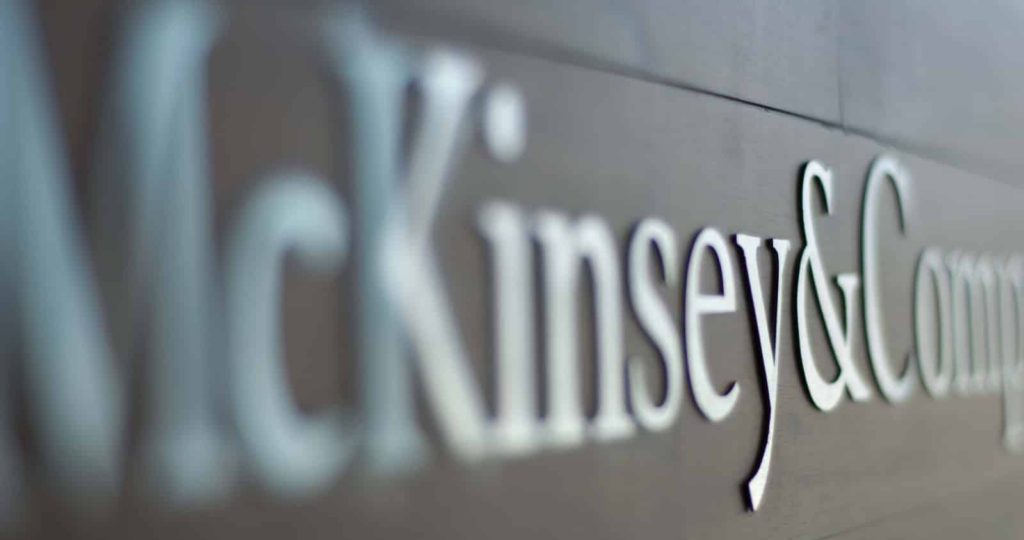Today, I will show you how to master the McKinsey case interview.
McKinsey is one of the most prestigious consulting firms.
And case interviews are a core component of McKinsey’s rigorous hiring process.
Therefore, this comprehensive guide will address the following:
What you can expect in a McKinsey case interview
Which criteria McKinsey uses to assess your case interview performance
The secrets for cracking any problems like a McKinsey consultant
And lots more to help you get a job offer at McKinsey.
Let’s dive right in.
Table of Contents
Understanding McKinsey Case Interviews
If you have just started your journey to a career in consulting or want to make sure you’re on the right track, you’ll love this chapter.
We’ll cover what a McKinsey case interview is (with examples) and how McKinsey interviewers assess candidates’ performance.
Let’s start with the definition of the McKinsey case interview.
What is a McKinsey Case Interview?
A McKinsey case interview is a job interview used to evaluate prospective consultants.
In this interview, candidates are presented with a problem to solve.
These problems reflect realistic projects McKinsey does for its clients.
This interview simulates the dynamics of real consulting work and allows the interviewer to gauge the candidate’s interpersonal skills and ability to collaborate in solving business problems.
8 McKinsey case interview questions examples
Here are 8 McKinsey sample cases from the McKinsey website:
Need more case interview examples?
Check out this page, where I’ve compiled over 280 free case interview examples.
Skills assessed during McKinsey case interviews
Your interviewers will assess if you possess the following soft skills and capabilities:
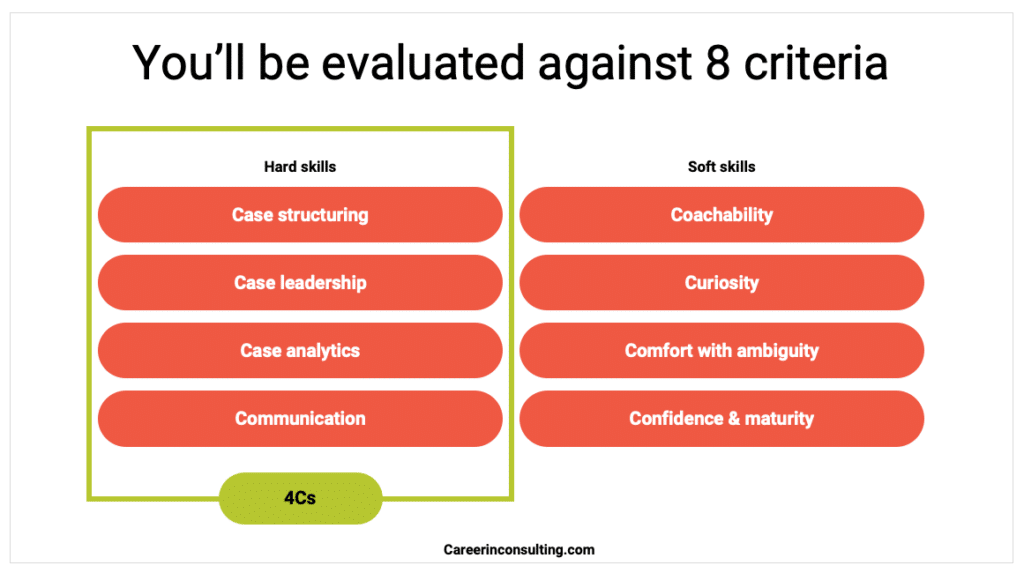
Case structuring
Case structuring involves organizing and outlining an approach to analyzing the problem methodically.
This skill is demonstrated by a candidate’s capability to break down complex problems into manageable parts, establish a logical framework for tackling each part, and systematically address the key issues.
Effective case structuring helps ensure that all critical aspects of the problem are considered and that the analysis proceeds in an organized manner.
Related article: the MECE principle.
Case leadership
Case leadership refers to the candidate’s ability to effectively prioritize tasks and apply the 80/20 rule (focusing on the 20% of efforts that will yield 80% of the results).
This skill is crucial for efficiently navigating the vast amount of information and potential analyses in a case interview to focus on the most impactful elements that will drive the most significant insights and value.
Case analytics
Case analytics is the ability to sift through data, interpret it correctly, and draw meaningful insights relevant to the case objectives.
In a case interview, this means handling numerical data accurately and understanding what the data implies for the business problem.
The skill lies in connecting analytical findings to the case question and informing strategic decisions or recommendations.
Related article: case interview math practice guide.
Communication skills
Communication encompasses the ability to articulate thoughts clearly, concisely, and persuasively.
It involves presenting ideas in a structured manner, ensuring the reasoning is easy to follow, and engaging effectively with the interviewer.
Coachability
Coachability refers to a candidate’s ability to apply feedback to improve performance.
It indicates flexibility in adapting their approach as needed.
In case interviews, coachability is assessed by observing how candidates respond to hints or corrections from the interviewer.
It’s crucial because consultants often work in rapidly evolving environments where they must continually learn and adjust strategies based on client needs or project dynamics.
Curiosity
Curiosity in case interviews is demonstrated by a candidate’s eagerness to explore deeper insights into the problem.
It involves asking thoughtful questions, seeking to understand the broader business context, and not just solving the problem mechanically.
Curiosity shows that a candidate is genuinely interested in the underlying issues of a case, which is critical to developing practical, innovative solutions beyond surface-level analysis.
Comfort with ambiguity
This term refers to a candidate’s ability to remain confident and decisive even when faced with incomplete information or uncertain situations.
This is a critical skill in consulting case interviews, as business problems often do not have clear-cut answers or may involve conflicting data.
Assessing comfort with ambiguity involves evaluating how well candidates handle unknowns without becoming overly stressed or indecisive.
Confidence and maturity
Confidence refers to the candidate’s ability to present their ideas assertively and clearly while demonstrating an understanding of the complexities involved in business issues.
Maturity is reflected in how candidates handle feedback, manage stress, and interact professionally during discussions, indicating their readiness to handle client-facing roles effectively.
The Importance of Case Interviews in McKinsey's Hiring Process
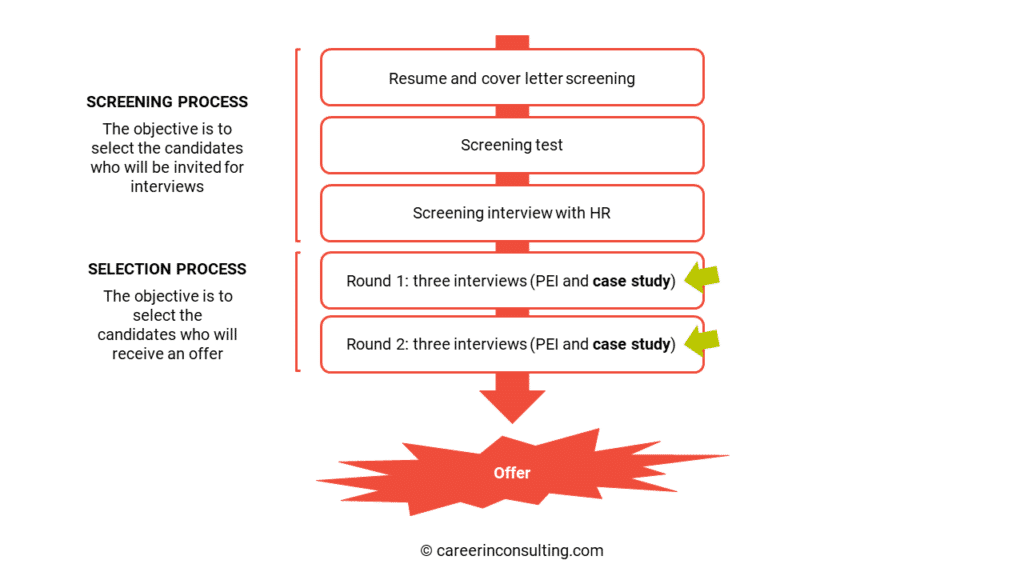
Here’s why case interviews are central to McKinsey’s hiring process:
Confidence and maturity
Case interviews provide a direct simulation of the daily job of McKinsey consultants.
They require candidates to engage with complex business scenarios, analyze data, and develop actionable solutions that closely mirror the work they would do as consultants.
Confidence and maturity
Communication is paramount in consulting, given the client-facing nature of the work.
Case interviews assess candidates’ abilities to communicate their thoughts clearly and persuasively and respond to feedback dynamically.
Additionally, this indicates how they will interact with clients and colleagues on real projects.
Confidence and maturity
Through the interactive nature of case interviews, McKinsey interviewers can evaluate candidates’ adaptability and cultural fit within the firm.
How candidates handle pressure, ambiguity, and teamwork during these interviews provides insights into their potential to thrive in McKinsey’s high-stakes, collaborative environment.
Confidence and maturity
Finally, case interviews are a litmus test for client readiness.
McKinsey looks for candidates who can solve complex problems and present their solutions in a client-ready manner, demonstrating professionalism and the ability to effectively engage stakeholders.
Step-by-Step Guide to Solving McKinsey Cases
Now that you understand what a McKinsey case interview is, it’s time to learn to solve it.
Specifically, we’ll discuss the 5-step process you must follow in all your case interviews:
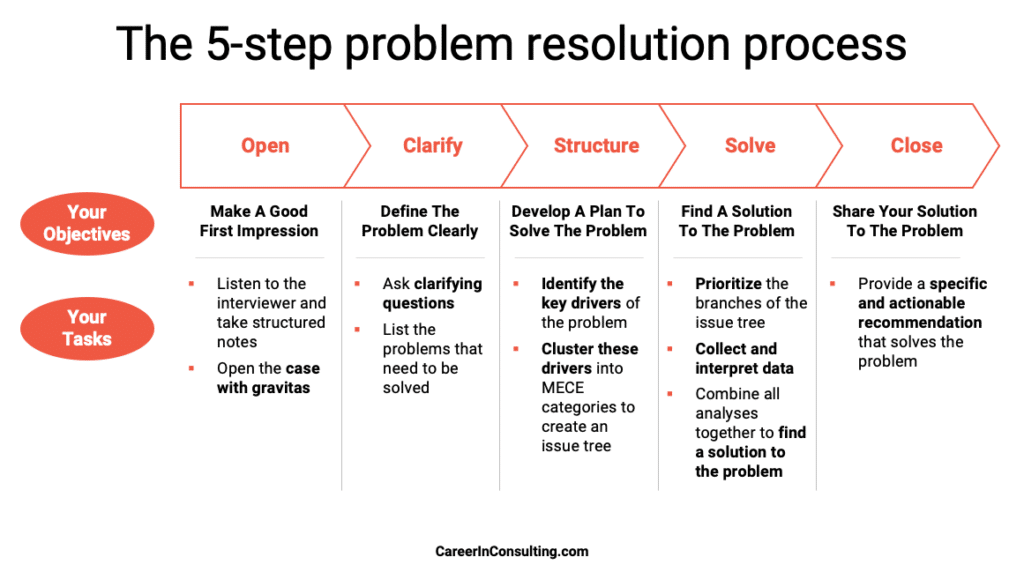
Let’s start with how to open a McKinsey case interview.
Open: Listening and taking notes
The case interview starts with your interviewer presenting a business problem.
Your job?
Listening and taking notes.
To do so, identify critical information such as:
keywords
numbers
unfamiliar terms.
And don’t worry: you can ask your interviewer to repeat a word or number you’ve missed.
After all, even McKinsey consultants are humans (I believe so)!
Clarify: Understanding the Problem Statement
In McKinsey case interviews, clarifying the problem statement is the first step toward solving the case.
It involves asking the right questions to understand what the interviewer expects fully.
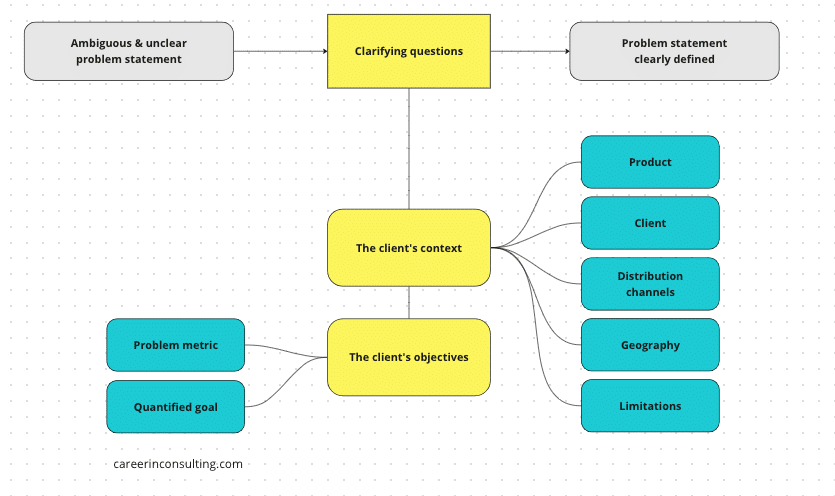
Understanding the context
First, it’s essential to grasp the overall context in which the client operates.
This involves understanding the client’s product, business model, and the geography in which they operate.
Questions you might ask include:
Can you describe our client’s business model?
How does our client make money today?
Where does our client operate?
Understanding the objectives
Next, it’s vital to understand how the client defines success.
Specifically, you must unambiguously understand the following:
Problem metric: the KPI the client wants to optimize
Objective: the quantified objective the client wants to achieve
Relevant questions might be:
What are the specific goals the client aims to achieve?
Are we focusing on increasing profitability, or is there another objective?
Related article: how to ask the right clarifying questions.
Structure: Crafting a Structured Approach
Next, you must develop a framework.
A framework is the list of all the mini problems that must be solved to resolve the main problem.

But this list of mini problems can NOT be a random list of issues.
You must follow a logical approach and organize your ideas in a MECE manner.
To do so, you must understand the concept of problem archetypes:
Diagnosis problems (or fix-something-bad problems)
Take-a-strategic-decision problems
Improve-a-metric problems

Next, let’s explore how to develop a case structure for each problem archetype.
Problem archetype 1: diagnosis problems
For this problem archetype, you must answer two questions:
Where: break down the problem metric into an equation to ISOLATE the problem.
The goal?
Understand what is numerically driving the problem metric in the wrong direction.
How?
By benchmarking actual and historical values for each variable in this equation.Why: List all the potential root causes that could explain the situation. Often, you must explore internal (e.g., an underperforming offer) and external (e.g., a sluggish market) potential root causes.
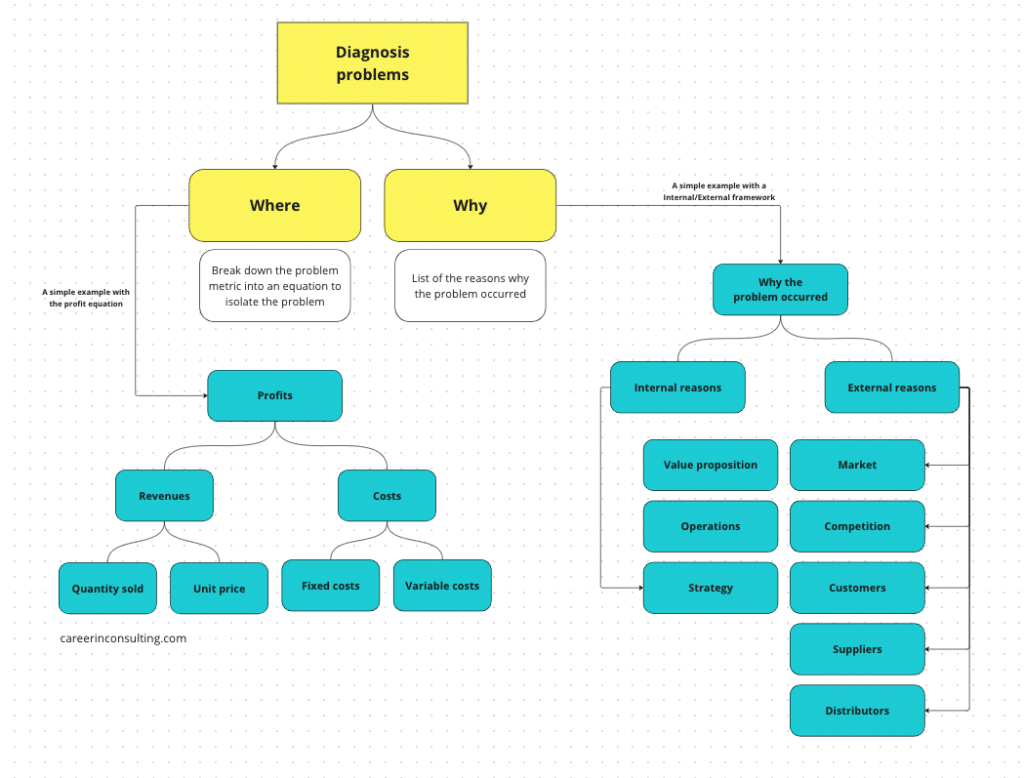
Problem archetype 2: take-a-decision problems
For this problem archetype, you must first identify all the conditions that must be true to take the condition.
For instance, a condition can be “this is economically viable” or “we’ll generate $1M of annual profits”.
Second, list the information you need to check if each condition is met.
For instance, you can explore the expected revenues and costs to estimate the profits generated by this decision.
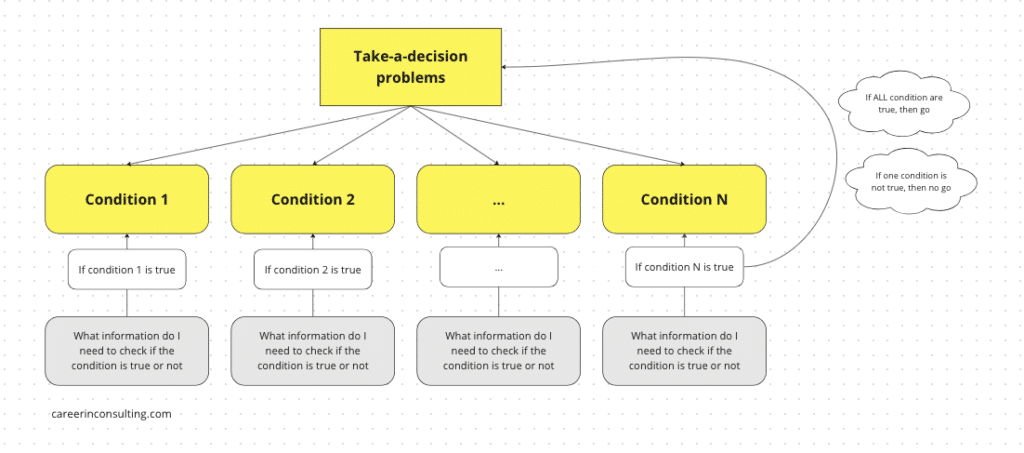
Problem archetype 3: improve-a-metric problems
For this problem archetype, you must first list the opportunities a client has to improve a metric.
To do so, like any brainstorming exercise, start by breaking down the metric you need to improve.
Next, brainstorm ideas to improve each variable of this equation.
But you’re not done yet.
You want to give your client a prioritized list of opportunities.
To do so, you must perform a cost-benefit analysis.

A complete (and free) case interview training
I’ve created a free case interview training to go deeper into the above concepts.
In this training, we’ll explore the different problem archetypes in detail and use many examples to illustrate some key concepts.
So, if you want a job offer, sign up today for this free training.
Also, you can watch the following video:
Solve: Finding a solution
It’s time to solve the mini-problems in your framework.
To do so, you’ll have to perform two types of analysis:
Quantitative analysis
Qualitative analysis (aka brainstorming questions)
Answering quantitative questions
These questions test a candidate’s ability to solve numerical problems commonly encountered in consulting work.
Quantitative questions can vary widely, but they typically fall into three categories:
Market Sizing: These questions ask candidates to estimate the size of a market. For example, “Estimate the market size for mobile phones in the United States.”
Interpret a chart: This type of question tests a candidate’s ability to extract and interpret data from graphical representations such as bar charts, pie charts, line graphs, or scatter plots.
Solve a math problem: These questions ask candidates to calculate something, often using a business formula. For example, a question might be, “Determine the break-even point for a company launching a new eco-friendly water bottle, given the fixed costs, variable costs per unit, and expected selling price per unit.”
Finally, here is how to approach quantitative questions:
Understanding the Question:
Begin by carefully listening to the quantitative question presented. Ensure you understand what is asked, identifying key variables and the desired outcome.
Planning the Approach:
Decide which mathematical operations, formulas, or analytical methods are most appropriate for addressing the question.
Executing Calculations:
Perform the calculations using a systematic approach. Use rough paper to keep track of your calculations and ensure accuracy. In case interviews, while speed is essential, correctness is crucial.
Validating Results:
Once the calculations are complete, please take a moment to review them. Check your arithmetic and ensure that your answer makes sense in the problem’s context.
Presenting Your Findings:
Highlight insights from the analysis and how they could impact the client’s decision-making process. Based on your results, suggest further areas of investigation.
Answering brainstorming questions
Brainstorming questions in consulting case interviews serves a unique purpose:
They assess candidates’ ability to think creatively and generate ideas under pressure.
For instance:
“How can Company X increase its market share?” or
“What new revenue streams can Company Y explore to offset declining sales?”
Answering brainstorming questions effectively in a consulting case interview involves a systematic approach that showcases your creativity and structured thinking.
Here’s how you can handle these questions:
Step 1: Listing Ideas
This phase is about quantity as much as quality, aiming to explore as many avenues as possible without immediate judgment or analysis.
Step 2: Organizing Your Ideas into MECE Categories
Once you have a comprehensive list, the next step is to refine and organize these ideas to ensure they are presented clearly and structured.
Close: Giving a recommendation
Finally, it’s time to share your recommendation.
This is where interviewers test your communication skills and whether you are client-ready.
And trust me:
This is where most candidates struggle with presenting their solutions clearly and concisely.
To structure your communication, start with your main findings, followed by supporting data, and conclude with your recommendations.
Want to learn how to do it?
Read the book “The Pyramid Principle” by Barbara Minto.
This is a must-read book if you want to have a career in consulting.
Differences between a McKinsey case interview and case interviews at other firms
All consulting firms use case interviews as part of their hiring process.
However, this chapter will address what makes McKinsey interviews different.
Let’s start with the case interview format.
Interviewer led vs. Candidate led case interviews
In consulting interviews, candidates will encounter two primary case interview formats:
candidate-led, or
interviewer-led case interviews.
Mckinsey use interviewer led case interview.
Conversely, other firms such as BCG or Bain use the candidate-led format.
So, let’s define each format and the implications for you.
Candidate-Led Case Interviews
In candidate-led interviews, the candidate takes the initiative to drive the problem-solving process.
Here, the interviewer presents the case problem and lets the candidate guide the discussion.
The candidate must propose a structured approach to solving the problem, identify the key issues to analyze, and ask relevant questions to obtain and analyze the data.
Interviewer-Led Case Interviews
In contrast, interviewer-led case interviews involve the McKinsey interviewer guiding the candidate through the case with targeted questions.
Each question is designed to evaluate specific skills and problem-solving abilities.
For instance, McKinsey interviewers can ask questions like:
“What are the key cost areas that impact the client’s profitability?”
“Can you calculate the impact of increased production costs on overall profit margins?”
Interviewer led cases: implications for your case interview prep
Short answer: none.
I always recommend that my clients know how to lead the case.
Even in a McKinsey case interview, you want to demonstrate your leadership skills and drive the case discussions by talking about the following analysis to perform.
That’s precisely what I teach in this free training.
Expectations from interviewers
McKinsey places an exceptionally high emphasis on the MECE principle and strategic thinking, even more so than its competitors.
McKinsey's Emphasis on the MECE Principle
While other firms also value structured thinking, McKinsey’s approach to problem-solving through the MECE lens is incredibly rigorous.
Candidates must demonstrate a highly structured thought process that systematically breaks down complex problems into neatly organized parts.
This meticulous attention to structure facilitates more precise insights and more effective solutions.
Related article: the complete guide on MECE principle.
Strategic Thinking
While other firms like BCG and Bain require strategic thinking, the depth and detail expected by McKinsey in articulating these strategic insights are often more demanding.
McKinsey interviewers expect candidates to provide solutions and articulate how these solutions fit into a larger strategic framework.
The competitiveness of McKinsey's recruiting process
McKinsey is the most prestigious consulting firm worldwide.
This makes the McKinsey interview process one of the most competitive.
It’s generally admitted that only 1% of applicants receive an offer, which the McKinsey CEO has confirmed many times.
Hence, tolerance to mistakes is lower (if not zero) than with other top consulting firms.
In other words, your case interview performance must be perfect!
Get 4 Complete Case Interview Courses For Free

You need 4 skills to be successful in all case interviews: Case Structuring, Case Leadership, Case Analytics, and Communication. Join this free training and learn how to ace ANY case questions.
First round interviews vs. second round interviews
To begin with, do not overthink the differences between first-round and later-round interviews.
From your preparation’s perspective, it should not change anything.
However, keep in mind the following differences between the first round interview and the final round interviews:
The seniority of the McKinsey interviewer (usually engagement managers, associate partners, or partners)
Stress
Competitiveness
Weight of assessment criteria
Focus on your weaknesses
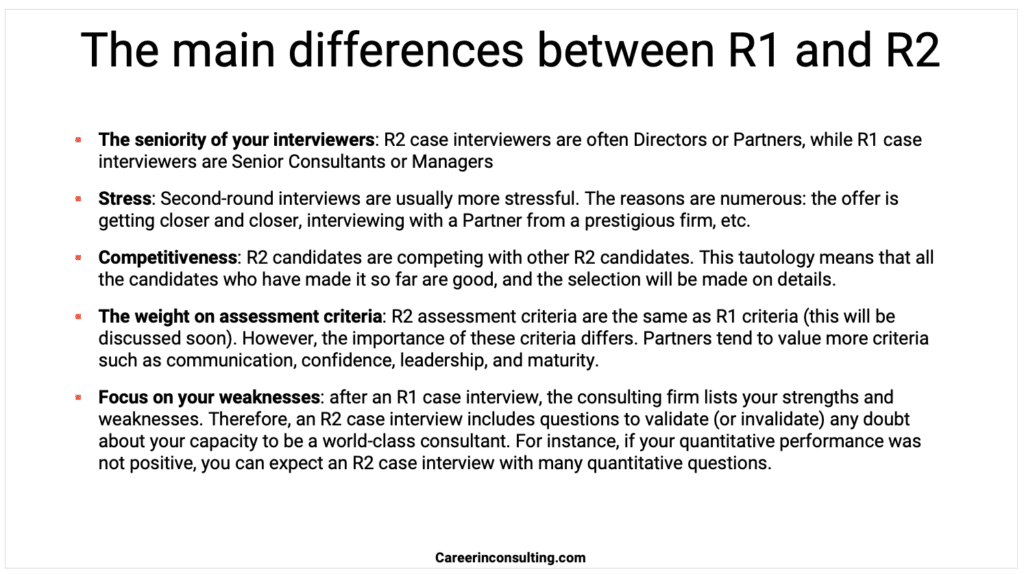
Common Pitfalls and How to Avoid Them
A top consulting firm like McKinsey has a ban policy:
If rejected, you can’t reapply for 18-24 months.
But I have good news.
In this chapter, I’ll show you the mistakes candidates make before, during, and after a case interview so you can avoid making the same!
Let’s dive in.
Insufficient preparation
Many candidates underestimate the complexity and intensity of McKinsey’s case interviews.
Successful preparation extends beyond familiarizing yourself with common case types.
Conversely, it involves rigorous practice and constantly seeking constructive feedback.
Therefore, adequate preparation includes:
Diverse Case Practice: Engage in various case types to build versatility.
Regular Mock Interviews: Simulate interview settings with peers or mentors and get feedback.
Lack of framework flexibility
Frameworks – like these ones – provide a structured way of approaching business problems.
But top consulting firms like McKinsey expect candidates to tweak or combine frameworks based on the specifics of the case question and the client’s unique situation.
Therefore, you must learn how to build tailored frameworks.
How?
Check this free training to learn how to develop tailored frameworks.
Neglecting the fit interview (PEI or Personal Experience Interview) component
McKinsey evaluates not only problem-solving skills but also cultural fit.
Actually, your performance during McKinsey PEI interviews counts for 50%.
To better prepare, candidates should:
Research Firm Culture: Understand and reflect McKinsey’s core values and mission.
Prepare Personal Stories: Develop stories highlighting qualities aligning with these values.
Mock Fit Interviews: Practice behavioral questions with peers or mentors to refine your personal experience interview answers.
Related article: how to answer McKinsey PEI questions.
Failure to clarify the objectives
A common pitfall is jumping into solving the case without clearly understanding the objectives.
At the start of the case, candidates should ask Clarifying Questions to frame the problem.
This article explains how to start a McKisney case interview correctly.
Overlooking key details
Candidates often miss key details that are critical to developing an effective solution.
Instead, candidates should:
Active Listening: Pay careful attention to all the information the interviewer provides.
Note-Taking: Develop efficient note-taking habits to capture all relevant details.
Review Notes: Review your notes during the interview to ensure all critical elements are considered.
Communication breakdown
The ability to articulate your thought process clearly and concisely is crucial.
However, many candidates get lost in details and are unstructured or unclear.
Instead, candidates should:
Structure Responses: Organize your thoughts and present them in a logical sequence.
Practice Clear Speaking: Focus on clarity and pace during mock interviews.
McKinsey case interview: final words
I hope you enjoyed this guide to the McKinsey case interview.
As a former consultant, I know how challenging and overwhelming the preparation can be.
But follow this guide’s strategies, and you’ll get your consulting offer!
Leave a comment below now if you have any questions.
Get 4 Complete Case Interview Courses For Free

You need 4 skills to be successful in all case interviews: Case Structuring, Case Leadership, Case Analytics, and Communication. Join this free training and learn how to ace ANY case questions.
